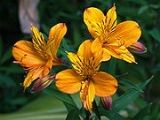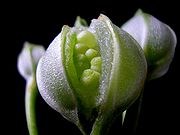
Alstroemeria
Encyclopedia


South America
South America is a continent situated in the Western Hemisphere, mostly in the Southern Hemisphere, with a relatively small portion in the Northern Hemisphere. The continent is also considered a subcontinent of the Americas. It is bordered on the west by the Pacific Ocean and on the north and east...
n genus of about 120 species of flowering plant
Flowering plant
The flowering plants , also known as Angiospermae or Magnoliophyta, are the most diverse group of land plants. Angiosperms are seed-producing plants like the gymnosperms and can be distinguished from the gymnosperms by a series of synapomorphies...
s. Almost all of the species are restricted to one of two distinct centers of diversity, one in central Chile, the other in eastern Brazil. Species of Alstroemeria from Chile are winter-growing plants while those of Brazil are summer-growing. All are long-lived perennials except A. (Taltalia) graminea, a diminutive annual from the Atacama Desert of Chile.
Etymology
The genus was named for the SwedishSweden
Sweden , officially the Kingdom of Sweden , is a Nordic country on the Scandinavian Peninsula in Northern Europe. Sweden borders with Norway and Finland and is connected to Denmark by a bridge-tunnel across the Öresund....
baron Clas Alströmer
Clas Alströmer
Baron Clas Alströmer was a Swedish naturalist who was a student of Carl Linnaeus at Uppsala University. From 1760–1764 he traveled throughout Southern Europe, collecting plants for Linnaeus. He established a botanical garden and natural museum near Gothenburg which was managed by the notable...
(Claus von Alstroemer 1736 - 1794) by his close friend Carolus Linnaeus
Carolus Linnaeus
Carl Linnaeus , also known after his ennoblement as , was a Swedish botanist, physician, and zoologist, who laid the foundations for the modern scheme of binomial nomenclature. He is known as the father of modern taxonomy, and is also considered one of the fathers of modern ecology...
. The plant was first described by the French botanist Louis Feuillée
Louis Feuillée
Louis Éconches Feuillée was a French member of the Order of the Minims, explorer, astronomer, geographer, and botanist....
. The plant's seeds were among many collected by Alströmer on a trip to South America
South America
South America is a continent situated in the Western Hemisphere, mostly in the Southern Hemisphere, with a relatively small portion in the Northern Hemisphere. The continent is also considered a subcontinent of the Americas. It is bordered on the west by the Pacific Ocean and on the north and east...
in 1753.
Characteristics
The plants are distinctive vegetatively, with a rootstock consisting of a slender rhizome or group of rhizomes (the "crown"). Storage roots consist of sausage-like water storing structures "suspended" from the rhizomeRhizome
In botany and dendrology, a rhizome is a characteristically horizontal stem of a plant that is usually found underground, often sending out roots and shoots from its nodes...
by major roots. In this way the root system resembles that of dahlias. Above-ground shoots may be very short in some alpine Andean species (a few inches tall) or up to about 5 feet (1.5 m) tall in other species. Each year (more often in some hybrids) up to 80 new shoots are produced from the rootstock and each terminates in an umbel of a few up to 10 or so flowers.
Perhaps the most fascinating- and telltale- morphological trait of Alstroemeria and its relatives is the fact that the leaves are resupinate, that is, they twist from the base so that what appears to be the upper leaf surface is in fact the lower leaf surface. This very unusual botanical feature is easily observed in the leaves on cut flowers from the florist.
The flowers of Alstroemeria are generally showy. All six tepals (tepal denotes either petal
Petal
Petals are modified leaves that surround the reproductive parts of flowers. They often are brightly colored or unusually shaped to attract pollinators. Together, all of the petals of a flower are called a corolla. Petals are usually accompanied by another set of special leaves called sepals lying...
or sepal
Sepal
A sepal is a part of the flower of angiosperms . Collectively the sepals form the calyx, which is the outermost whorl of parts that form a flower. Usually green, sepals have the typical function of protecting the petals when the flower is in bud...
when both are similar, as in lilies, amaryllis, etc.) are roughly similar. In some species two tepals are enlarged and vividly colored and act as "flags" for pollination. The ovary is inferior and the seeds are hard and rounded.
See also Bomarea
Bomarea
Bomarea is one of the two major genera in the plant family Alstroemeriaceae. Most occur in the Andes. Several species are occasionally found as garden plants....
, the other major genus in the Alstroemeriaceae. They are essentially twining Alstroemerias (though some species are not vining), with most species occurring in the Andes
Andes
The Andes is the world's longest continental mountain range. It is a continual range of highlands along the western coast of South America. This range is about long, about to wide , and of an average height of about .Along its length, the Andes is split into several ranges, which are separated...
.
Alstroemeria is named after the Swedish botanist Baron Klas von Alstroemer.
Cultivation and uses

Cultivar
A cultivar'Cultivar has two meanings as explained under Formal definition. When used in reference to a taxon, the word does not apply to an individual plant but to all those plants sharing the unique characteristics that define the cultivar. is a plant or group of plants selected for desirable...
s have been developed, with different markings and colors, ranging from white, golden yellow, and orange, to apricot, pink, red, purple, and lavender. The most popular and showy hybrids commonly grown today result from crosses between species from Chile (winter-growing) with species from Brazil (summer-growing). This strategy has overcome the problem of seasonal dormancy and resulted in plants that are evergreen, or nearly so, and flower for most of the year. This breeding work derives mainly from trials that began in the United States in the 1980s. The flower, which resembles a miniature lily, is very popular for bouquets and flower arrangements in the commercial cut flower trade. It has a vase life
Vase life
Vase life is the period of time during which a cut flower or cut foliage retains its appearance in a vase. This is a major consideration in identifying plant species suitable for use in the cut flower industry, plants with a long vase life being far more desirable than those with a short vase life....
of about two weeks. It is sometimes also called 'Ulster Mary' (a corruption of the genus name).
Most cultivars available for the home garden will bloom in the late spring and early summer. The roots are hardy to a temperature of 23 °F (-5 °C). The plant requires at least six hours of morning sunlight, regular water, and well-drained soil.
Other accepted names
- Alstroemeria achirae
- Alstroemeria altoparadisea
- Alstroemeria amabilis
- Alstroemeria amazonica
- Alstroemeria andina
- Alstroemeria andina subsp. andina
- Alstroemeria andina subsp. venustula
- Alstroemeria angustifolia
- Alstroemeria angustifolia subsp. angustifolia
- Alstroemeria angustifolia subsp. velutina
- Alstroemeria annapolina
- Alstroemeria apertiflora
- Alstroemeria aquidauanica
- Alstroemeria arnicana
- Alstroemeria aulica
- Alstroemeria aurea
- Alstroemeria bahiensis
- Alstroemeria bakeri
- Alstroemeria bilabiata
- Alstroemeria brasiliensis
- Alstroemeria burchellii
- Alstroemeria cabralensis
- Alstroemeria caiaponica
- Alstroemeria cantillanica
- Alstroemeria capixaba
- Alstroemeria caryophyllaea
- Alstroemeria chapadensis
- Alstroemeria chorillensis
- Alstroemeria crispata
- Alstroemeria cuiabana
- Alstroemeria cultrifolia
- Alstroemeria cunha
- Alstroemeria decora
- Alstroemeria diluta
- Alstroemeria diluta subsp. chrysantha
- Alstroemeria diluta subsp. diluta
- Alstroemeria discolor
- Alstroemeria douradensis
- Alstroemeria espigonensis
- Alstroemeria exserens
- Alstroemeria fiebrigiana
- Alstroemeria firmulifolia
- Alstroemeria foliosa
- Alstroemeria fuscovinosa
- Alstroemeria garaventae
- Alstroemeria gardneri
- Alstroemeria glaucandra
- Alstroemeria gouveiana
- Alstroemeria graminea
- Alstroemeria hookeri
- Alstroemeria hookeri subsp. cummingiana
- Alstroemeria hookeri subsp. hookeri
- Alstroemeria hookeri subsp. maculata
- Alstroemeria huemulina
- Alstroemeria ibitipocae
- Alstroemeria igarapavica
- Alstroemeria inodora
- Alstroemeria isabellana
- Alstroemeria itabiritensis
- Alstroemeria itatiaica
- Alstroemeria jequitiana
- Alstroemeria jocunda
- Alstroemeria julieae
- Alstroemeria kingii
- Alstroemeria lactilutea
- Alstroemeria landimana
- Alstroemeria leporina
- Alstroemeria ligtu
- Alstroemeria ligtu subsp. incarnata
- Alstroemeria ligtu subsp. ligtu
- Alstroemeria ligtu subsp. simsii
- Alstroemeria ligtu subsp. splendens
- Alstroemeria litterata
- Alstroemeria longaviensis
- Alstroemeria longistaminea
- Alstroemeria longistyla
- Alstroemeria lutea
- Alstroemeria magna
- Alstroemeria magnifica
- Alstroemeria magnifica subsp. gayana
- Alstroemeria magnifica subsp. magenta
- Alstroemeria magnifica subsp. magnifica
- Alstroemeria magnifica subsp. maxima
- Alstroemeria magnifica subsp. tofoensis
- Alstroemeria malmeana
- Alstroemeria modesta
- Alstroemeria mollensis
- Alstroemeria monantha
- Alstroemeria monticola
- Alstroemeria nidularis
- Alstroemeria nivea
- Alstroemeria ochracea
- Alstroemeria orchidioides
- Alstroemeria oreas
- Alstroemeria pallida
- Alstroemeria patagonica
- Alstroemeria paupercula
- Alstroemeria pelegrina
- Alstroemeria penduliflora
- Alstroemeria philippii
- Alstroemeria piauhyensis
- Alstroemeria plantaginea
- Alstroemeria poetica
- Alstroemeria polpaicana
- Alstroemeria polyphylla
- Alstroemeria presliana
- Alstroemeria presliana subsp. australis
- Alstroemeria presliana subsp. presliana
- Alstroemeria pseudospathulata
- Alstroemeria pubiflora
- Alstroemeria pudica
- Alstroemeria pulchella
- Alstroemeria pulchra
- Alstroemeria pulchra subsp. lavandulacea
- Alstroemeria pulchra subsp. pulchra
- Alstroemeria punctata
- Alstroemeria pygmaea
- Alstroemeria radula
- Alstroemeria recumbens
- Alstroemeria revoluta
- Alstroemeria ribeirensis
- Alstroemeria roseoviridis
- Alstroemeria rupestris
- Alstroemeria sabulosa
- Alstroemeria schizanthoides
- Alstroemeria sellowiana
- Alstroemeria spathulata
- Alstroemeria speciosa
- Alstroemeria spectabilis
- Alstroemeria stenopetala
- Alstroemeria talcaensis
- Alstroemeria timida
- Alstroemeria tombolatoana
- Alstroemeria umbellata
- Alstroemeria variegata
- Alstroemeria venusta
- Alstroemeria versicolor
- Alstroemeria virginalis
- Alstroemeria viridiflora
- Alstroemeria werdermannii
- Alstroemeria werdermannii var. flavicans
- Alstroemeria werdermannii var. werdermannii
- Alstroemeria xavantinensis
- Alstroemeria yaelae
- Alstroemeria zoelneri

